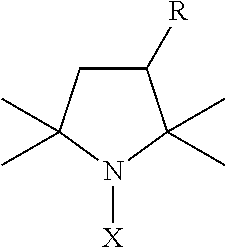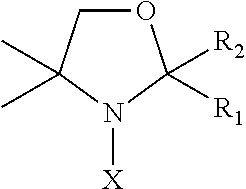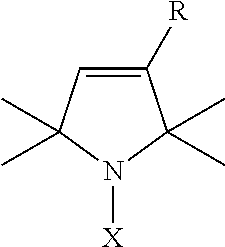Nitroxides for use in treating or preventing neoplastic disease
a technology of neoplastic disease and nitroxide, which is applied in the field of pharmaceutical compositions, can solve the problems of difficult cure, damage to cell structures, and the inability of the defense mechanism to eliminate all cellular radicals
- Summary
- Abstract
- Description
- Claims
- Application Information
AI Technical Summary
Benefits of technology
Problems solved by technology
Method used
Image
Examples
example 1
[0084]A 70-kilogram patient diagnosed with cancer is administered a dose of 1500 mg of Tempol per day for 180 days. This may be administered in a single dose, or may be administered as a number of smaller doses over a 24-hour period: for example, three 500-mg doses at eight-hour intervals. Following treatment, the protein levels of elongation factor-1 delta, ADAM12, cathepsin B, peroxisome proliferator-activated receptor-δ, hypoxia-inducible factor alpha subunit, superoxide dismutase 2, uncoupling protein 2, and cyclooxygenase 1 in the cancerous tissue are reduced, and the levels of mitogen-activated protein kinase kinase 5, glutathione S-transferase M3, PERP, sirtuin 2, and brain protein I3 are increased.
example 2
[0085]A 70-kilogram patient with familial risk factors for cancer but exhibiting no symptoms thereof is administered a dose of 1500 mg of Tempol per day for 180 days. This may be administered in a single dose, or may be administered as a number of smaller doses over a 24-hour period: for example, three 500-mg doses at eight-hour intervals. Following treatment, the protein levels of elongation factor-1 delta, ADAM12, cathepsin B, peroxisome proliferator-activated receptor-δ, hypoxia-inducible factor alpha subunit, superoxide dismutase 2, uncoupling protein 2, and cyclooxygenase 1 in the cancerous tissue are reduced, and the levels of mitogen-activated protein kinase kinase 5, glutathione S-transferase M3, PERP, sirtuin 2, and brain protein I3 are increased.
PUM
| Property | Measurement | Unit |
|---|---|---|
| Dimensionless property | aaaaa | aaaaa |
| Dimensionless property | aaaaa | aaaaa |
| Dimensionless property | aaaaa | aaaaa |
Abstract
Description
Claims
Application Information
 Login to View More
Login to View More - R&D
- Intellectual Property
- Life Sciences
- Materials
- Tech Scout
- Unparalleled Data Quality
- Higher Quality Content
- 60% Fewer Hallucinations
Browse by: Latest US Patents, China's latest patents, Technical Efficacy Thesaurus, Application Domain, Technology Topic, Popular Technical Reports.
© 2025 PatSnap. All rights reserved.Legal|Privacy policy|Modern Slavery Act Transparency Statement|Sitemap|About US| Contact US: help@patsnap.com



